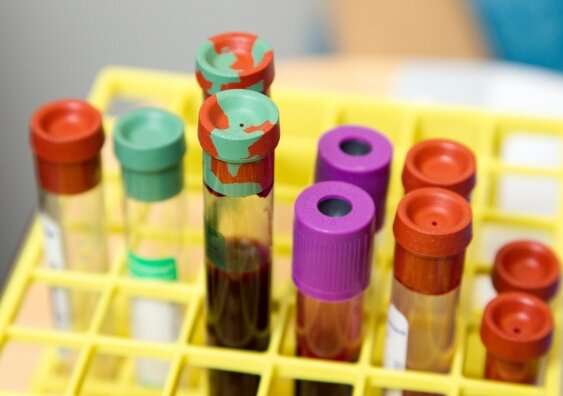New sensor could guide cancer treatment options in patients

Researchers at UNSW Sydney have found a way to detect a very low amount of a cancer biomarker in undiluted blood in just 15 minutes, a result that could eventually play a key role in evaluating the effectiveness of cancer treatments.
The researchers at UNSW Science's School of Chemistry, The Australian Center for NanoMedicine, and ARC Center of Excellence in Convergent Bio-Nano Science and Technology are hoping the technology to detect the PD-L1 biomarker in a blood sample will be available in the next five years.
PD-L1—or programmed death-ligand 1—is a protein that is known to help tumor cells evade the immune system by preventing the activation of T-cells which are used to destroy cancer.
It is a predictive biomarker for several types of cancers such as melanoma skin cancer, colorectal and bladder cancer as well as non-small-cell lung cancer.
Researchers currently find PD-L1 levels using immunohistochemistry tests from a biopsy, or by using a scan or imaging techniques.
Now the UNSW researchers, have released nanoparticles in blood samples to detect very low amounts of PD-L1 in undiluted whole blood for the first time.
"The nanoparticles are, in effect, dispersible electrodes," first author and Ph.D. Candidate in the School of Chemistry under supervison of Scientia Professor Justin Gooding, Parisa Moazzam says.
"When they are circulated through the matrices of undiluted whole blood, they capture PD-L1, a cancer biomarker, before a magnet is used to re-collect the nanoparticles with newly attached PD-L1."
The findings have been published in Chemical Communications.
Ms Moazzam says the levels of PD-L1 in patients with cancer can show a strong correlation with the predicted response to immunotherapy and assessment of cancer treatment outcomes.
"A PD-L1 expression measurement in the blood means researchers can potentially identify patients who might respond well to immunotherapy treatment and evaluate treatment responses," she says.
Ms Moazzam says while immunotherapy is showing excellent therapeutic results in multiple cancers for some patients, it is expensive.
Current tests for PD-L1 only result in relative amounts of the biomarker, but she says this latest research can give absolute amounts, which greatly increases sensitivity and test accuracy.
"This is the first electrochemical detection process which has the potential to improve conventional tests with an early, sensitive and accurate diagnosis; to reduce treatment costs; and improve outcomes and patient survival rate," she says.
Ms Moazzam said she is now working on detecting other immune inhibitor biomarkers in human serum, plasma and blood.
The research group is also working to develop a high-throughput test with screen-printed electrochemical sensors.
"This technology is not only of interest to Australia's medical and diagnostic services, but also in worldwide clinical services laboratories in the UK and the US," she says.
The finding follows work by UNSW researchers in 2018, which modified gold-coated magnetic nanoparticles with DNA to match the microRNAs they wanted to detect in half of a whole blood sample, to diagnose cancer and other illnesses quickly and more efficiently.
More information: Parisa Moazzam et al. Ultrasensitive detection of programmed death-ligand 1 (PD-L1) in whole blood using dispersible electrodes, Chemical Communications (2021). DOI: 10.1039/D0CC08068C



















